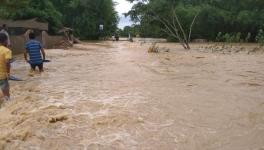Assam Ground Report: Still Reeling Under Last Year’s Losses, People Face Flood Wrath Again
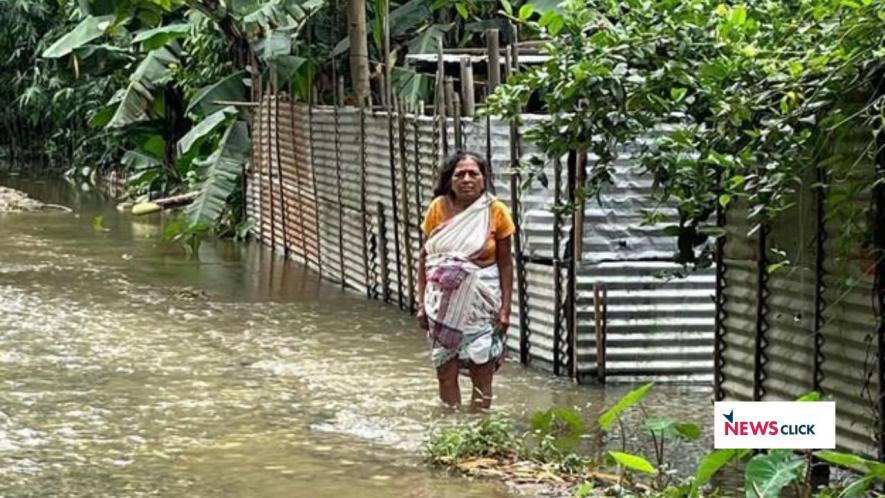
When an embankment is breached, the water in large volume flows down so powerfully and speedily that no one gets enough time to vacate their houses. | Images by Sandipan Talukdar
With the arrival of the first spell of monsoon, lakhs of people in Assam are facing the fury of floods again, even before fully reviving from the losses they bore last year. In many places in the past year, people were struggling with their lives amidst government apathy and failure to provide requisite compensation, when the flood struck again, washing away homes, livestock and other belongings. In addition, places that were spared last year are also facing massive floods and resultant losses.
Bajali district (now Barpeta, as announced by the Assam’s Chief Minister on December 31, 2022) witnessed unprecedented floods last year. The same river, Pahumara, is again causing havoc.
Similarly, the swollen river Kaldia is affecting people, as it did last year. NewsClick visited some areas in the Barpeta district affected by floods.
Pahumara River Continues to Ravage
Pahumara, flowing from Bhutan, passes through an extended area in Assam's Bajali (Barpeta district) before meeting Brahmaputra. Medhikuchi, Doloigaon, and Dongarpar are a few places in the Bhawanipur area that bear the brunt of the raging river.
On June 22, early in the morning (around 3 am), an old embankment passing through the village Dui no Medhikuchi (Medhikuchi from here on) was breached, with water gushing into the village, taking along whatever came in its way.
Pankaj Talukdar, a villager, described the horror the villagers witnessed that night.
"We detected that the embankment no longer resisted water flowing from the other side. We noticed water seeping from the bottom of the embankment in the evening. This was an indication that it (the embankment) could not protect our village," he told NewsClick.
The villagers acted quickly and tried their best to protect the embankment.
"Many of us gathered and decided to fill in the bostas (cement bags) with soil or sand and went down to the bottom of the embankment. This would prevent the water current from breaching the embankment," he added.
Embankments in Assam have been constructed with soil and sand having different heights, with some more than 20-25 feet from the level of the river. The height depends upon the topography of the place where an embankment has been constructed. These embankments also serve as pitched roads. These have been erected to protect places from overflowing water from rivers. The number of embankments increased during the post-Independence period till the 1980s. During massive floods, these embankments are often breached by gushing water, causing immense devastation.
That day, the villagers' efforts did not succeed and they could not save much of their belongings. Talukdar said the paddy stock in his granary was damaged and livestock affected.
"This year, I will likely face a loss of Rs 2-3 lakh," he said.
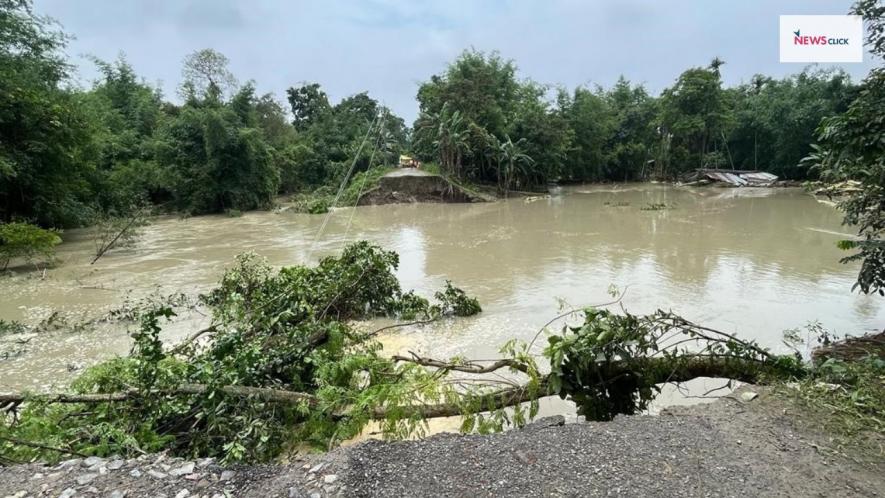
The embankment breached in Medhikuchi. The water from the Pahumara river came from the left side and inundated the village.
The same is the case with others. When an embankment is breached, the water in large volume flows down so powerfully and speedily that no one gets enough time to vacate their houses. The villagers had to take shelter over the embankments.
Assam minister Piyush Hazarika visited the place late noon that day.
“He brought reporters along, did photo sessions, talked to contractors and then left. Some of us tried to approach him and tell him about the losses we would face, but he chose not to listen to us,” said a villager whose poultry farm was destroyed.
The villagers rushed to the embankment amidst heavy rain and managed some tents.
“All night we had to keep standing”, said Malati, describing the problems, especially for women, in such situations.
“Only the next day, when the rain ceased, some officials came. But they could not provide us with tents. There is a huge scarcity of food. We are not able to light the stoves till late afternoon,” she told NewsClick.
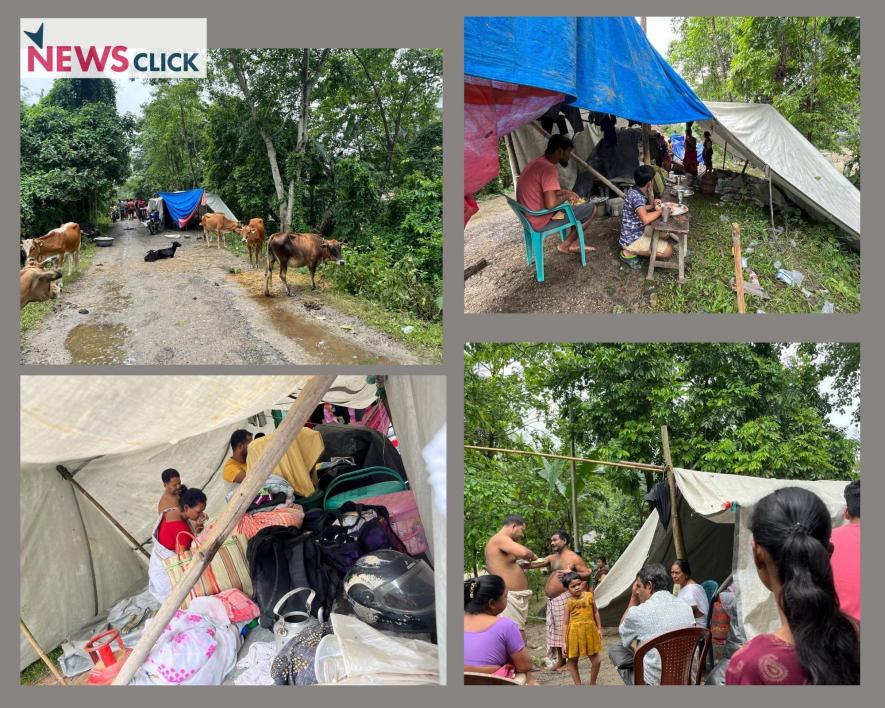
People sheltered themselves under tents, living aside the livestock; Medhikuchi village, Barpeta, Assam.
NewsClick also met Surendra Chowdhury, secretary of the Bajali Anchalik Krishak Sabha (CPI-M), who had come there to take stock of the situation.
“Pahumara has inundated several other places, like Bamakhata. The embankments are not maintained properly, and it seems the authorities wait for them to be breached so that someone can make money. The Assam flood has to be declared a national problem,” he said.
He added, “There has to be a specialised government team at each of the vulnerable places of Assam; a widespread network of such employees is necessary. The local MLA Phani Talukdar is indifferent to these larger issues.”
The affected area comes under the Bhawanipur Assembly (The delimitation draft published recently has changed some of the constituencies in Assam).
That the embankment was not in proper shape was also confirmed by some villagers of Medhikuchi.
“Termites and rats had made holes at the bottom of it. There was no maintenance. The voluminous water breached the embankment at those weak places,” said Pankaj Talukdar.
The embankment passing through the village was built in the late 1960s, according to some elderly villagers. The same embankment breached one or half kilometre away at Medhikuchi village last year.
Some villagers also took shelter in a nearby temple. Here, mostly the women were seen resting.
Chitralekha Talukdar told NewsClick that her husband had died in the earlier flood. Last year’s flood also took away paddy from her granary, and she did not get any relief.
“This year also, my livestock is facing threat. How can we survive if we lose our properties every year and the government does not support us?” she said.
The local dispensary provided some basic medicines, including ointment, diclofenac and paracetamol. But when NewsClick visited the place (June 22), the villagers said they were still awaiting government aid.
A few kilometres away, at Birbira and Doloigaon area, the same embankment was breached on the same day (June 22) and almost the same time as Medhikuchi. This area comes under the Patacharkuchi Assembly constituency, and Ranjit Das, the food and supply minister, represents it.
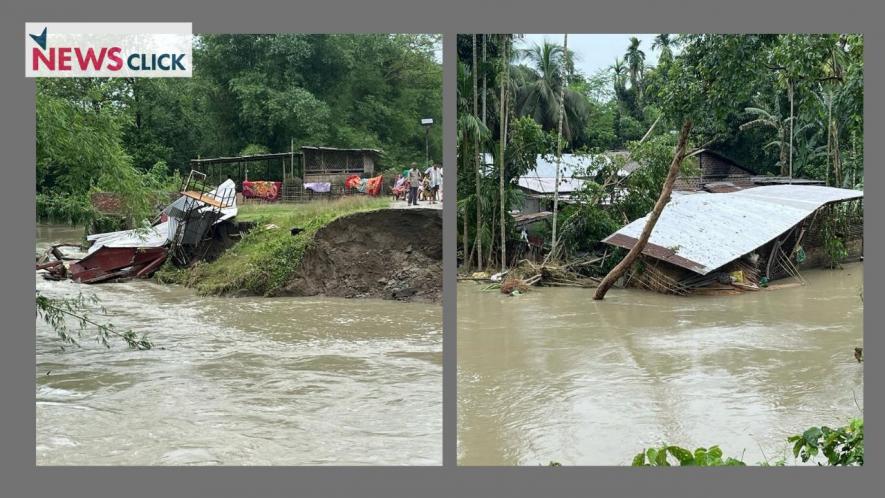
The situation after breaching of the embankment; Birbira/Doloigaon, Patacharkuchi Assembly constituency.
At Birbira, from one side of the breached embankment, NewsClick reached the other side by crossing the strong water current. People were entrapped there and were waiting for relief material to be provided by United Club, Kenduguri, in the absence of government aid.
When asked whether the state disaster management team visited the area to find anyone trapped inside houses, locals said that only in the late afternoon did a steamer come to survey the area.
"But they did not provide any relief material. This portion has been cut off from others as water is flowing with high speed above the road," said one of the affected villagers.
NewsClick also spoke to Mridul Talukdar, advisor of United Club and also a general secretary of the AJYCP (Assam Jatiyatabadi Yuva Chatra Parishad). He said all the money the club received was being spent on such activities every year. United Club is busy providing relief material, like rice, dal, potato, oil and drinking water to almost all Bajali places. Affected people at Medhikuchi, Doloigaon, and Birbira also told NewsClick about the club's help during the disaster.
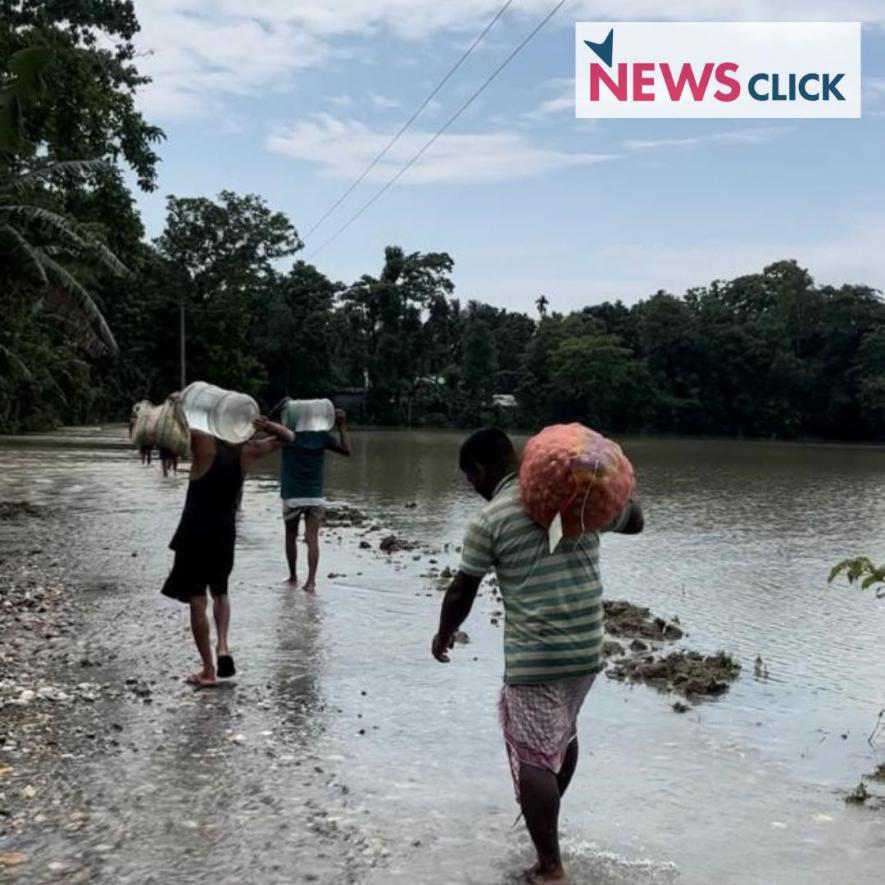
Self-help during a disaster; United Club volunteers ferrying water to those trapped on the other side.
The villagers there appeared enraged against Das, the local MLA.
“We have heard that he will visit the place today (June 23). Steamers and the disaster management authority’s people are here to carry the minister. He is the supply minister and an MLA from this constituency. Still, he could not provide us relief,” said one of the villagers.
Many people present there were also victims of last year’s flood. They said they did not get full compensation, as CM declared by the CM last year, and were still awaiting it.
Floods in Assam are linked to the dams in Bhutan and Arunachal Pradesh. At the north bank of Brahmaputra, the western districts of the lower Assam division (Kamrup, Nalbari, Barpeta, Bongaigaon, Kokrajhar, Baksa, Chirang etc.), all the rivers, basically tributaries of Brahmaputra, flow down from Bhutan. Some of these rivers also originate in Tibet before flowing through Bhutan.
Several big dams fall under the India-Bhutan treaties; some are functional, and some are under construction. The Kurichhu Dam (at the Kurichhu river in upstream Bhutan) releases water several times through its gates when the water load at the dam shoots up during heavy rainfall. This year also, the Kurichhu dam released excess water that threatened the people of Bajali area.
Locals at Medhikuchi and Birbira said they were aware of Bhutan releasing water from the Kuricchu dam.
Subrat Talukdar, a CPI (ML) activist, said, “Kuricchu releases water every year, and for the past few years, the Pahumara has become increasingly furious. This year, they released water. But as the water level is receding, there can be further release of water within a few days if rain continues in Bhutan’s hills.”
(To be continued)
Get the latest reports & analysis with people's perspective on Protests, movements & deep analytical videos, discussions of the current affairs in your Telegram app. Subscribe to NewsClick's Telegram channel & get Real-Time updates on stories, as they get published on our website.











